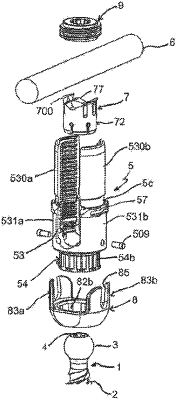| CPC A61B 17/7037 (2013.01) [A61B 17/7032 (2013.01); A61B 17/7035 (2013.01)] | 20 Claims |

|
1. A bone anchoring device comprising:
a receiving part for coupling a rod to a bone anchoring element, the receiving part having a first end, a second end, and a central axis extending in a single straight line between the first end and the second end, the receiving part comprising:
two legs defining a recess at the first end for receiving the rod; and
a head receiving portion at the second end that is at least partially expandable and having an opening at the second end for inserting and pivotably holding a head of the bone anchoring element therein; and
a locking ring mountable around the head receiving portion and movable axially relative to the receiving part in a direction parallel to the central axis, the locking ring comprising a tool engagement surface configured to be engaged by a tool for rotating the locking ring around the central axis to increase a compressive force exerted on the head receiving portion,
wherein the tool engagement surface has at least a first portion that is spaced apart circumferentially from the recess for receiving the rod, and wherein the first portion faces the first end of the receiving part and is arranged at an incline relative to the central axis as the first portion extends circumferentially around the locking ring.
|